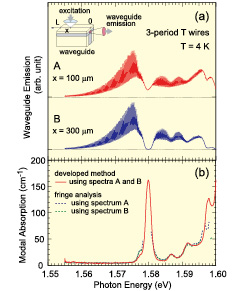Quantitative Waveguide Absorption Spectroscopy of Nano-Structures
Akiyama Group
New absorption-spectroscopy methods that utilize internal photoluminescence light as a source for probe light are developed, and used to measure the quantitative absorption spectra of quantum wires and a single quantum well embedded in an optical waveguide.

Fig. 1. (a) Waveguide-emission spectra of 3-period T wires embedded in T-shaped optical waveguide at 4 K under point photoexcitation at x=100 and 300 μm from cavity edge. Inset shows schematic view of experimental configuration. (b) Absorption spectra derived from waveguide-emission spectra shown in (a) using developed analysis method (solid line) and using Fabry–Pérot fringe analysis (dotted lines).
By applying this method to two-dimensional excitons in an un-doped 8 nm GaAs/AlAs single quantum well, we characterized possible errors and accuracy of this method. In addition, we compared the measured absorption spectra with photoluminescence-excitation (PLE) spectra. It was found that the lowest exciton peak in the PLE spectra at low temperatures was deviated from that in the absorption spectra. This effect was attributed to the de-excitation via resonant-Rayleigh-scattering processes, which has been known as the Heitler effect.
We also applied this method to one-dimensional (1D) excitons in T-shaped quantum wires, as shown in Fig. 1, and evaluated the modal absorption area of the 1D ground-state excitons as 0.39 eV cm−1, which was almost independent of temperature in the range 4–150 K. This revealed that the absorption cross-section per unit length at resonance peak and the spectrally integrated absorption cross-section area per unit length of the 1D ground-state excitons were 1.0 nm and 2.5 × 10−3 eV nm, respectively. We confirmed that this value is consistent with the intrinsic radiative lifetime of 1D excitons evaluated separately.
References
- [1] T. Mochizuki et al., Jpn. J. Appl. Phys. (to be published).
- [2] M. Yoshita et al., Appl. Phys. Lett. 100, 112101 (2012).
